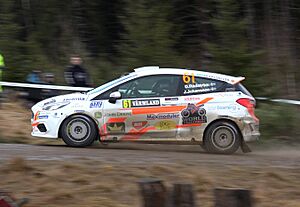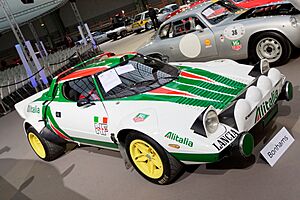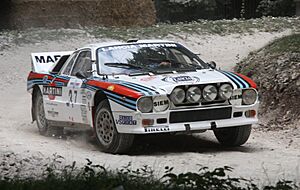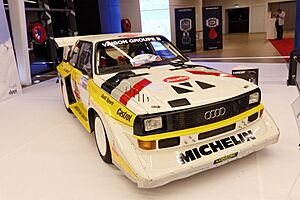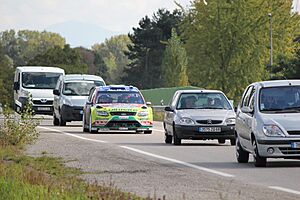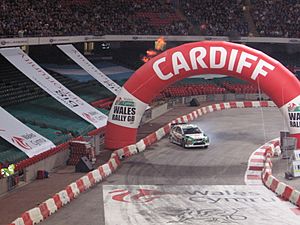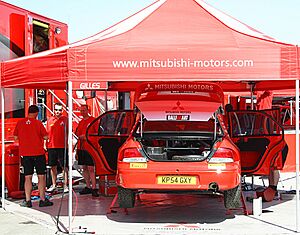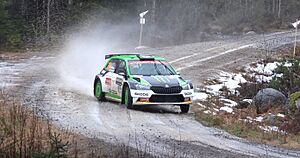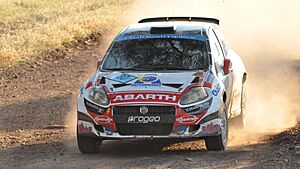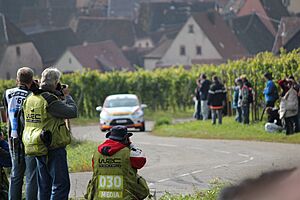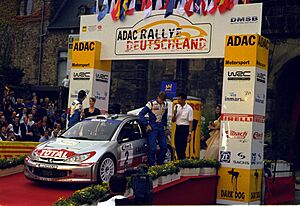World Rally Championship facts for kids
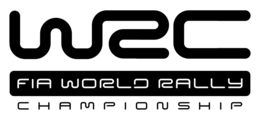 |
|
| Category | Rallying |
|---|---|
| Country | International |
| Inaugural season | 1973 |
| Manufacturers | 3 |
| Tyre suppliers | Hankook |
| Drivers' champion | |
| Co-Drivers' champion | |
| Manufacturers' champion | |
The World Rally Championship (or WRC) is an exciting international racing series. It's all about rally cars speeding on different roads around the world! The FIA organizes and runs this championship. It started in 1973, making it one of the oldest world championships, right after Formula One.
Each WRC season happens over one year. It usually has about 13 rallies. These events last three to four days. Drivers race on all kinds of surfaces, like gravel, asphalt, snow, and ice. Each rally has many special stages. These are closed roads where drivers race against the clock. They cover up to 350 kilometers of these special stages.
Drivers, their co-drivers, and car manufacturers all compete for separate championship titles. There are also other championships like WRC2 and WRC3. These use the same rally events but with cars that have different performance levels. Younger drivers can compete in Junior WRC on five of the main WRC events.
Contents
How WRC Champions Are Crowned
The WRC has different championships. This makes it exciting for many types of teams and drivers!
World Rally Championship for Car Makers
Car manufacturers, like Toyota or Hyundai, compete for their own title. They must sign up and use special Group Rally1 cars in every rally. These are the fastest cars, driven by top drivers. These teams usually earn the most points. They get "Priority 1" status, meaning they race the stages first.
World Rally Championships for Drivers and Co-Drivers
Any driver and co-driver in a WRC rally can earn points for these titles. It doesn't matter what car they drive or how many rallies they enter. Co-drivers usually navigate, but they can drive if there's an emergency.
Exciting Support Championships
The WRC also has other championships. These are called WRC2 and WRC3. They use the same rally routes as the main WRC. But they have stricter rules for the cars allowed.
WRC2: Rally2 Cars in Action
WRC2 uses Rally2 cars. Drivers, co-drivers, and teams all compete for titles. Drivers can enter up to 7 events, with their best 6 scores counting. Teams enter two cars in up to 7 events. Points are also given for the "Power Stage." WRC2 drivers get "Priority 2" status. They race right after the P1 crews. In 2023, the WRC2 Challenger championship started. It's for drivers who haven't won WRC2 before.
WRC3: Rally3 Cars for Private Teams
WRC3 uses Rally3 cars. This championship is for drivers and co-drivers who are privateers. It has lower entry costs than WRC2. Drivers can enter up to 5 rallies, with their best 4 scores counting. WRC3 crews get "Priority 3" status. They race after the WRC2 crews.
Junior WRC: Future Stars of Rallying
Junior WRC is for younger drivers. They use Ford Fiesta Rally3 cars. These cars are provided by M-Sport. Drivers must be under 29 years old. Titles are given to drivers and co-drivers. Co-drivers don't have an age limit.
WRC Masters Cup: Rallying for Experienced Drivers
The FIA WRC Masters Cup started in 2023. It's for drivers and co-drivers over 50 years old. They can use any WRC-eligible car, except the top Rally1 cars.
| Evolution of the WRC Championships | |||||||||||||||||||||||||||||||||||||||||||||||||||||
|---|---|---|---|---|---|---|---|---|---|---|---|---|---|---|---|---|---|---|---|---|---|---|---|---|---|---|---|---|---|---|---|---|---|---|---|---|---|---|---|---|---|---|---|---|---|---|---|---|---|---|---|---|---|
| 1970 | 1980 | 1990 | 2000 | 2010 | 2020 | ||||||||||||||||||||||||||||||||||||||||||||||||
| 3 | 4 | 5 | 6 | 7 | 8 | 9 | 0 | 1 | 2 | 3 | 4 | 5 | 6 | 7 | 8 | 9 | 0 | 1 | 2 | 3 | 4 | 5 | 6 | 7 | 8 | 9 | 0 | 1 | 2 | 3 | 4 | 5 | 6 | 7 | 8 | 9 | 0 | 1 | 2 | 3 | 4 | 5 | 6 | 7 | 8 | 9 | 0 | 1 | 2 | 3 | 4 | 5 | |
| Overall Championships | Manufacturers | ||||||||||||||||||||||||||||||||||||||||||||||||||||
| FIA Cup | Drivers and Co-Drivers | ||||||||||||||||||||||||||||||||||||||||||||||||||||
| Support Championships | PWRC | WRC 3 (2WD) | WRC 3 | ||||||||||||||||||||||||||||||||||||||||||||||||||
| JWRC | JWRC | ||||||||||||||||||||||||||||||||||||||||||||||||||||
| 2 Litre Cup | SWRC | WRC 2 | |||||||||||||||||||||||||||||||||||||||||||||||||||
A Look Back at WRC History
The Early Days of Rallying
The WRC started in 1973. It grew from many famous international rallies. The very first WRC season began with the Monte Carlo Rally. Alpine-Renault won the first manufacturer's title with their Alpine A110 car. Then, Lancia won three times in a row with the Lancia Stratos HF. This car was special because it was built just for rallying!
The first official driver's championship was awarded in 1979. Sweden's Björn Waldegård became the first world champion. Before that, there was an "FIA Cup for Drivers." Famous drivers like Sandro Munari and Markku Alén won this cup. Other car makers like Fiat, Ford, and Talbot also won titles in these early years.
The Exciting Group B Era
The 1980s brought super-fast Group B cars. These cars had amazing power and four-wheel-drive. Audi was a pioneer with its Audi Quattro. Other manufacturers quickly followed. Group B cars were incredibly powerful. Audi won manufacturer titles in 1982 and 1984. Drivers like Hannu Mikkola and Stig Blomqvist also won titles for Audi.
However, the Group B era also had serious safety concerns. There were several tragic accidents involving drivers and spectators. Because of these incidents, the sport's governing body decided to ban Group B cars from 1987. This was to make rallying safer for everyone.
The Group A Era and Japanese Dominance

After Group B, Group A cars became the main type of rally car. Lancia quickly adapted and dominated. Their Lancia Delta HF won six manufacturer titles in a row! Drivers like Juha Kankkunen and Miki Biasion won multiple titles with Lancia.
In the 1990s, Japanese car makers took over. Toyota, Subaru, and Mitsubishi became the top teams. Carlos Sainz won titles with Toyota. Kankkunen also won his fourth title with Toyota. Then, Colin McRae won for Subaru. Tommi Mäkinen won an amazing four driver championships in a row with Mitsubishi.
The Modern World Rally Car Era
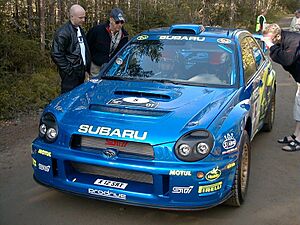
In 1997, new World Rally Car rules were introduced. This made it easier for new car makers to join. After the Japanese teams, Peugeot made a strong comeback. Marcus Grönholm won titles for Peugeot. Then, Richard Burns won for Subaru.
A French driver named Sébastien Loeb then dominated the sport. He won nine championships in a row with Citroën! Later, Sébastien Ogier continued this French success. He won six titles, mostly with Volkswagen. Hyundai also returned to the series in 2014. New, faster World Rally Cars were introduced in 2017.
In 2018, Toyota won their first manufacturer's title since 1999. Ott Tänak broke the long streak of French champions in 2019. He won the driver's title. Hyundai won the manufacturer's title in 2019 and 2020. Ogier won again in 2020 and 2021 with Toyota. The classic World Rally Car era ended in 2021 after 25 years.
How WRC Rallies Work
The WRC Calendar: Rallies Around the World
Each WRC season has many rallies. These events happen throughout the year. They usually take place on at least three different continents. In the past, WRC has visited almost every continent! Recently, there have been about 13 rallies each year. These rallies feature different road surfaces. Drivers race on gravel, asphalt, snow, and ice.
Rally Stages and Road Sections
A rally is made up of "special stages." These are closed roads where drivers race against the clock. Between these stages, cars drive on "road sections." These are public roads. Drivers must follow all traffic laws. A "road book" tells crews where to go. They also have a "timecard" to track their progress. A typical day involves driving about 400 kilometers.
Most rallies have 15 to 30 special stages. These stages can be short, under 2 km, or long, over 50 km. The total length of special stages is usually up to 350 km. Some stages are called "super special stages." These are often short and designed for spectators. They might even have two cars racing at the same time!
Since 2021, rallies usually have only one type of road surface. This means cars don't need big changes during the rally. In the past, some rallies had both gravel and asphalt days. This required teams to change tires and car settings. Asphalt setups use 18-inch wheels, while gravel and snow use 13-inch wheels.
A WRC event starts with "reconnaissance" (recce). This is when crews drive through the stages. They create or update their "pace notes." On Thursday, teams have a "shakedown" stage. This is for practice and testing car setups. The competition usually starts on Thursday or Friday. It ends on Sunday with the "Power Stage." Cars start stages a few minutes apart.
Each rally has a main "service park." Here, cars are prepared and repaired. Some rallies also have smaller service areas closer to the stages. After each day's racing, cars are put into "parc fermé." This is a secure area where teams cannot work on their cars.
Championship Points: How Winners Are Decided
Points are given out after each rally. These points add up for the world championship titles. The drivers and manufacturers with the most points at the end of the season win. Until 2023, points were based on the final rally results. Since 2011, extra points have been given for the "Power Stage." A new points system was introduced for the 2024 season.
Manufacturers choose up to three crews to score points for them. The two fastest nominated crews earn points for the manufacturer. A driver can win the driver's championship, while a different manufacturer wins their title. This has happened many times, including in 2018, 2019, 2020, and 2024.
The Exciting Power Stage
The "Power Stage" was first used in 2011. It's the very last stage of a rally. It's often shown live on TV. The five fastest drivers and co-drivers on this stage get extra championship points. The fastest gets five points, the second fastest gets four, and so on. Since 2021, manufacturers can also score Power Stage points. This stage is timed very precisely, down to a thousandth of a second!
Restarting After Retirement
If a crew has to stop racing, they can often restart the next day. For each stage they miss, a time penalty is added to their overall time. This rule, once called "SuperRally" or "Rally 2," helps teams get more value from their efforts. It also gives spectators more action. Now, restarting is common, and crews are expected to do so unless they officially withdraw.
WRC Rally Cars
The rules for WRC cars are set by the FIA. In the beginning, WRC cars were based on regular production cars. But since 2022, Group Rally1 cars are special "Competition Cars." They are built just for racing.
Car rules change over time. This happens for safety, to use new technology, or to attract more car makers. Cars are grouped by their performance. RC1 cars are the fastest, and RC5 cars are the lowest performance allowed in WRC.
To enter a WRC rally in 2022, cars must be approved in certain groups or classes. These include World Rally Car 1.6L, and various Groups Rally and Group R cars.
World Rally Car 1.6L
These cars have 1.6L direct injection turbo engines. They also have four-wheel drive. Their power is limited to about 280 kW. The "WRC+" cars, like the Ford Fiesta WRC, were used by top teams. Older WRC cars from 2011, like the Volkswagen Polo R WRC, are also allowed. 2021 was the last year for these cars at the top level.
Groups Rally: Modern Rally Cars
The Groups Rally includes six types of rally cars for WRC.
- Rally1 cars started in 2022. They replaced the World Rally Car. These cars use hybrid power for the first time in rallying. They also have simpler parts to help save costs.
- Rally2 cars are the second fastest. They are the only cars allowed in WRC2.
- Rally2-Kit cars are also allowed. Rally2 and Rally2-Kit cars are in the same RC2 category.
- Rally3 cars started in 2021. They are used in WRC3.
- Rally4 cars and Rally5 cars are also part of Groups Rally. They don't have their own specific support championships.
Group R Cars
The Group R category started in 2008. These cars replaced older Group A and Group N cars. Group R cars are classified by their engine size, wheelbase, and drivetrain. Many older cars could be updated to fit Group R rules.
Now, R3 and R-GT cars from Group R are still allowed. R3 cars are in the RC4 sporting class. Neither R3 nor R-GT cars have their own WRC support championships.
Historically Eligible Cars
When WRC began in 1973, cars from different groups were allowed. These included Group 1, Group 2, Group 3, and Group 4. In 1982, new groups were created: Group N, Group A, and Group B.
Group B cars were banned in 1987 due to safety concerns. After that, Group A cars became the top choice for manufacturers. Private teams often used budget-friendly Group N cars. Group N cars were allowed in WRC2 until 2016.
In 1997, the World Rally Car was introduced. This made it easier to develop new cars. In 2011, World Rally Cars changed to use smaller 1.6L engines. Further changes in 2017 made cars faster and safer.
Super 2000 cars were allowed in rallies from 2007 to 2018. They were also part of the Super 2000 World Rally Championship from 2010 to 2012. Super 1600 cars were used in Junior WRC until 2010.
| Evolution of Car Groups and Classes used in the WRC Manufacturers Championship | ||||||||||||||||||||||||||||||||||||||||||||||||||||||
|---|---|---|---|---|---|---|---|---|---|---|---|---|---|---|---|---|---|---|---|---|---|---|---|---|---|---|---|---|---|---|---|---|---|---|---|---|---|---|---|---|---|---|---|---|---|---|---|---|---|---|---|---|---|---|
| 1970 | 1980 | 1990 | 2000 | 2010 | 2020 | |||||||||||||||||||||||||||||||||||||||||||||||||
| 3 | 4 | 5 | 6 | 7 | 8 | 9 | 0 | 1 | 2 | 3 | 4 | 5 | 6 | 7 | 8 | 9 | 0 | 1 | 2 | 3 | 4 | 5 | 6 | 7 | 8 | 9 | 0 | 1 | 2 | 3 | 4 | 5 | 6 | 7 | 8 | 9 | 0 | 1 | 2 | 3 | 4 | 5 | 6 | 7 | 8 | 9 | 0 | 1 | 2 | 3 | 4 | 5 | ||
| Series Production | Group 4 | Group B | ||||||||||||||||||||||||||||||||||||||||||||||||||||
| Group 3 | ||||||||||||||||||||||||||||||||||||||||||||||||||||||
| Group 2 | Group A | World Rally Car 2.0L | World Rally Car 1.6L | |||||||||||||||||||||||||||||||||||||||||||||||||||
| Group 1 | Group N | |||||||||||||||||||||||||||||||||||||||||||||||||||||
| Competition Car | Rally1 | |||||||||||||||||||||||||||||||||||||||||||||||||||||
| Summary of Car Groups and Classes otherwise permitted to enter rallies or in support championships | ||||||||||||||||||||||||||||||||||||||||
|---|---|---|---|---|---|---|---|---|---|---|---|---|---|---|---|---|---|---|---|---|---|---|---|---|---|---|---|---|---|---|---|---|---|---|---|---|---|---|---|---|
| 1980 | 1990 | 2000 | 2010 | 2020 | ||||||||||||||||||||||||||||||||||||
| 7 | 8 | 9 | 0 | 1 | 2 | 3 | 4 | 5 | 6 | 7 | 8 | 9 | 0 | 1 | 2 | 3 | 4 | 5 | 6 | 7 | 8 | 9 | 0 | 1 | 2 | 3 | 4 | 5 | 6 | 7 | 8 | 9 | 0 | 1 | 2 | 3 | 4 | 5 | ||
| Group N | N4 (>2.0L) | PWRC | WRC2 | |||||||||||||||||||||||||||||||||||||
| N1-N3 (<=2.0L) | PWRC | PWRC 2.0L Cup |
PWRC | PWRC JWRC |
PWRC | WRC2 | ||||||||||||||||||||||||||||||||||
| Group A | A8 (>2.0L) | |||||||||||||||||||||||||||||||||||||||
| A5-A7 (<=2.0L) | 2.0L Cup | JWRC | ||||||||||||||||||||||||||||||||||||||
| Super 1600 | JWRC Only | |||||||||||||||||||||||||||||||||||||||
| Super 2000 | PWRC | SWRC | WRC2 | |||||||||||||||||||||||||||||||||||||
| WRC 1.6L | ||||||||||||||||||||||||||||||||||||||||
| Group R & Groups Rally |
R1 (Rally5) | JWRC | PWRC | WRC3 | ||||||||||||||||||||||||||||||||||||
| R2 (Rally4) | JWRC | JWRC PWRC |
JWRC WRC3 |
WRC3 | JWRC WRC3 |
JWRC | ||||||||||||||||||||||||||||||||||
| R3 | JWRC | PWRC | WRC3 | JWRC WRC3 |
WRC3 | |||||||||||||||||||||||||||||||||||
| RGT | ||||||||||||||||||||||||||||||||||||||||
| R4 / (Rally2-Kit) | SWRC PWRC |
WRC2 | Excl-Europe | |||||||||||||||||||||||||||||||||||||
| R5 (Rally2) | WRC2 | WRC2 WRC3 |
WRC2 | |||||||||||||||||||||||||||||||||||||
| Rally3 | WRC3 | |||||||||||||||||||||||||||||||||||||||
Rally Tyres
Rally cars use different tyres for different surfaces. There are special tyres for dry asphalt, wet asphalt, gravel, snow, and ice. Some snow and ice tyres have studs for extra grip. Tyres also come in different hardness levels. Teams are not allowed to cut their own tread patterns.
For the 2023 season, Rally1 cars could use a maximum of 28 tyres per rally.
WRC Promotion and Coverage
WRC Promoter GmbH manages all the business side of WRC. This includes media coverage, sponsorships, and encouraging new teams. They share news, articles, and images with media outlets for free. The WRC.com website and mobile apps provide news, live rally times, results, and championship standings.
In 2014, a special online video service called WRC+ started. It offered video clips and live broadcasts of some stages. In 2018, WRC+ All Live began. For the first time, every special stage was shown live for selected cars. Commentary was available in English, Spanish, German, and Japanese.
In 2023, WRC+ All Live became part of a new service called Rally.TV. This service also covers the FIA World Rallycross Championship and the European Rally Championship. It offers a live TV channel with footage and documentaries between events. Short, free videos are also shared on social media platforms like YouTube and Facebook.
WRC TV creates previews, daily highlights, and event reviews for TV. Some TV stations also show the Power Stage and other stages live. In 2016, over 700 million people worldwide watched WRC TV programs. This grew to 836 million in 2019.
WRC Podcasts
An official WRC podcast is often produced. The latest version, "Backstories," has interviewed many drivers and co-drivers since 2020.
WRC Records and Statistics
Top Manufacturers
21 different car makers have won a WRC event. These include Citroën, Ford, Lancia, and Toyota. Another 11 manufacturers have finished on the podium. Lancia has won the most manufacturer championships, with ten titles.
WRC Champions


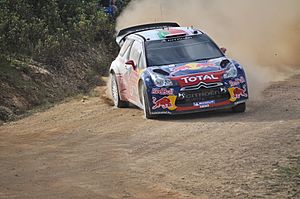

Here are some of the champions and their cars throughout WRC history:
| Season | Championship for drivers | Championship for manufacturers | ||
|---|---|---|---|---|
| Driver | Car | Manufacturer | Car | |
| 1973 | No drivers' championship | Alpine-Renault A110 | ||
| 1974 | Lancia Stratos HF | |||
| 1975 | Lancia Stratos HF | |||
| 1976 | Lancia Stratos HF | |||
| 1977 | Lancia Stratos HF | Fiat 131 Abarth | ||
| 1978 | Fiat 131 Abarth | Fiat 131 Abarth | ||
| 1979 | Ford Escort RS1800 | Ford Escort RS1800 | ||
| 1980 | Fiat 131 Abarth | Fiat 131 Abarth | ||
| 1981 | Ford Escort RS1800 | Talbot Sunbeam Lotus | ||
| 1982 | Opel Ascona 400 | Audi Quattro | ||
| 1983 | Audi Quattro | Lancia Rally 037 | ||
| 1984 | Audi Quattro | Audi Quattro | ||
| 1985 | Peugeot 205 Turbo 16 | Peugeot 205 Turbo 16 | ||
| 1986 | Peugeot 205 Turbo 16 E2 | Peugeot 205 Turbo 16 E2 | ||
| 1987 | Lancia Delta HF 4WD | Lancia Delta HF 4WD | ||
| 1988 | Lancia Delta Integrale | Lancia Delta Integrale | ||
| 1989 | Lancia Delta Integrale | Lancia Delta Integrale | ||
| 1990 | Toyota Celica GT-Four | Lancia Delta Integrale 16V | ||
| 1991 | Lancia Delta Integrale 16V | Lancia Delta Integrale 16V | ||
| 1992 | Toyota Celica Turbo 4WD | Lancia Delta HF Integrale | ||
| 1993 | Toyota Celica Turbo 4WD | Toyota Celica Turbo 4WD | ||
| 1994 | Toyota Celica Turbo 4WD | Toyota Celica Turbo 4WD | ||
| 1995 | Subaru Impreza 555 | Subaru Impreza 555 | ||
| 1996 | Mitsubishi Lancer Evolution III | Subaru Impreza 555 | ||
| 1997 | Mitsubishi Lancer Evolution IV | Subaru Impreza WRC | ||
| 1998 | Mitsubishi Lancer Evolution V | Mitsubishi Lancer Evolution V | ||
| 1999 | Mitsubishi Lancer Evolution VI | Toyota Corolla WRC | ||
| 2000 | Peugeot 206 WRC | Peugeot 206 WRC | ||
| 2001 | Subaru Impreza WRC 2001 | Peugeot 206 WRC | ||
| 2002 | Peugeot 206 WRC | Peugeot 206 WRC | ||
| 2003 | Subaru Impreza WRC 2003 | Citroën Xsara WRC | ||
| 2004 | Citroën Xsara WRC | Citroën Xsara WRC | ||
| 2005 | Citroën Xsara WRC | Citroën Xsara WRC | ||
| 2006 | Citroën Xsara WRC | Ford Focus RS WRC 06 | ||
| 2007 | Citroën C4 WRC | Ford Focus RS WRC 06/07 | ||
| 2008 | Citroën C4 WRC | Citroën C4 WRC | ||
| 2009 | Citroën C4 WRC | Citroën C4 WRC | ||
| 2010 | Citroën C4 WRC | Citroën C4 WRC | ||
| 2011 | Citroën DS3 WRC | Citroën DS3 WRC | ||
| 2012 | Citroën DS3 WRC | Citroën DS3 WRC | ||
| 2013 | Volkswagen Polo R WRC | Volkswagen Polo R WRC | ||
| 2014 | Volkswagen Polo R WRC | Volkswagen Polo R WRC | ||
| 2015 | Volkswagen Polo R WRC | Volkswagen Polo R WRC | ||
| 2016 | Volkswagen Polo R WRC | Volkswagen Polo R WRC | ||
| 2017 | Ford Fiesta WRC | Ford Fiesta WRC | ||
| 2018 | Ford Fiesta WRC | Toyota Yaris WRC | ||
| 2019 | Toyota Yaris WRC | Hyundai i20 Coupe WRC | ||
| 2020 | Toyota Yaris WRC | Hyundai i20 Coupe WRC | ||
| 2021 | Toyota Yaris WRC | Toyota Yaris WRC | ||
| 2022 | Toyota GR Yaris Rally1 | Toyota GR Yaris Rally1 | ||
| 2023 | Toyota GR Yaris Rally1 | Toyota GR Yaris Rally1 | ||
| 2024 | Hyundai i20 N Rally1 | Toyota GR Yaris Rally1 | ||
| 2025 | Toyota GR Yaris Rally1 | Toyota GR Yaris Rally1 | ||
Event Wins by Driver and Manufacturer
Updated after the 2025 Rally Saudi Arabia. Drivers and manufacturers who are currently active in the 2025 World Rally Championship are shown in bold.
|
|
|
WRC Video Games and Esports
Many video games have been made about the World Rally Championship. Some focus on specific cars or drivers. Sega Rally (1995) and V-Rally (1997) were arcade-style games. The Colin McRae Rally series, starting in 1998, brought more realistic racing.
The first official WRC: World Rally Championship game came out in 2001 for PlayStation 2. Richard Burns Rally (2004) is known for its very realistic driving. Newer popular games include Colin McRae: DiRT 2 and Dirt 3. Gran Turismo 5 also features WRC cars.
In 2010, Black Bean Games released WRC: FIA World Rally Championship. It included cars and drivers from the 2010 season. The WRC video game license was later taken over by Kylotonn. They released WRC 5 in 2015 and continued with new games. The WRC license passed to Codemasters for 2023 to 2027.
eSports WRC is an online championship. It uses the latest official WRC video game. It started in 2016 and is free to join. Each season ends with a Grand Finale. Competitors gather to race each other, often at a real rally event. Some eSports champions, like Jon Armstrong, also race in real rallies!
See also
 In Spanish: Campeonato Mundial de Rally para niños
In Spanish: Campeonato Mundial de Rally para niños


